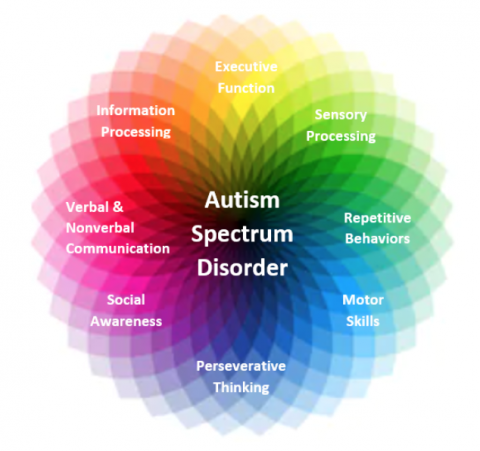Recognizing the Spectrum: A Comprehensive Overview to Autism Awareness
Wiki Article
Discovering Autism: Techniques for Efficient Communication and Interaction
Effective communication and communication with individuals on the autism spectrum demand a thorough understanding of their unique demands and choices. The ins and outs of these methods expose additional considerations that warrant exploration, especially in exactly how they can be adapted to private experiences and varied contexts.Understanding Autism Spectrum Disorder
Autism Spectrum Problem (ASD) includes a variety of neurodevelopmental conditions defined by obstacles in social interaction, communication, and repeated behaviors. The term "spectrum" shows the diverse symptoms and varying levels of seriousness experienced by individuals with ASD. While some may display considerable impairments, others may display high-functioning qualities, permitting for higher freedom in every day life.The beginning of ASD usually occurs in early childhood, with indicators usually identifiable by age 2. Early signs may include delayed speech advancement, minimal eye contact, and problems in comprehending social cues. The accurate etiology of ASD continues to be uncertain, research suggests a combination of ecological and genetic elements plays an important role in its growth.
People with ASD typically have one-of-a-kind toughness, such as heightened interest to information and exceptional memory skills. They may battle with comprehending abstract concepts and managing modifications to regular - autism. Therefore, interventions and support customized to private needs are necessary for promoting interaction and social abilities. Identifying the intricacy of ASD is crucial for promoting understanding, acceptance, and efficient strategies that help with significant interactions with people on the range.

Importance of Clear Communication
Effective interaction is essential for cultivating understanding and link, especially for people with Autism Range Disorder (ASD) Clear communication not only assists in social communications but likewise boosts the individual's ability to express their feelings, needs, and ideas. For people with ASD, the subtleties of language can typically be challenging; therefore, making use of distinct and uncomplicated language is necessary.Additionally, clear communication helps in reducing aggravation and anxiousness that may occur from misunderstandings. When messages are shared in a consistent and straight way, individuals with ASD are better equipped to interpret details properly, which can considerably enhance their social involvement and involvement in various setups.
Developing routines and utilizing visual assistances can additionally reinforce clear communication. These approaches provide individuals with foreseeable structures that aid comprehension and retention of details. In addition, actively listening and being person throughout interactions advertises an encouraging setting where people with ASD really feel valued and recognized.
Eventually, prioritizing clear interaction not only equips people with ASD however likewise fosters more purposeful connections with their peers, caregivers, and the broader area, leading the way for joint partnerships and inclusive communications. - autism
Non-Verbal Communication Techniques
Communication extends beyond words, and for individuals with Autism Spectrum Disorder (ASD), non-verbal signs play a substantial function in interactions. Non-verbal interaction methods can consist of facial expressions, motions, body language, and eye contact, all of which work as important components for sharing feelings and objectives.Recognizing and analyzing these non-verbal signals can enhance communications with people with ASD. For instance, a warm smile or open stance can develop a welcoming atmosphere, motivating involvement. Making use of aesthetic help-- such as photo cards or symbols-- can connect interaction spaces and help share messages more properly.
It is likewise essential to be conscious of personal space, as individuals with ASD may have different convenience levels regarding closeness. Observing their reactions to physical closeness can inform suitable modifications.

Producing Supportive Settings
Developing an encouraging environment is vital for cultivating favorable communications and improving the wellness of people with Autism Spectrum Problem (ASD) Such settings can dramatically decrease anxiousness and produce a sense of security, allowing people to express themselves extra freely.To attain this, it is vital to take into consideration sensory sensitivities that people with ASD may experience. Changing the physical space to consist of soft illumination, minimal background sound, and comfortable seats can create a calming ambience. In addition, utilizing consistent regimens and clear aesthetic routines can assist individuals anticipate transitions and decrease uncertainty, further promoting comfort.
Social spaces should be structured to lessen overwhelming stimulations while supplying possibilities for interaction in favored activities. Assisting in areas designated for peaceful time can additionally function as a refuge throughout minutes of stress and anxiety. Importantly, including components of selection encourages people, permitting them to work out company in their atmosphere.

Encouraging Social Interactions
Fostering social communications amongst individuals with Autism Range Disorder (ASD) requires intentional strategies that focus on convenience and interaction. Establishing foreseeable regimens can assist minimize stress and anxiety, making social setups extra approachable. Producing organized atmospheres with specified obligations and functions enables individuals to involve without the frustrating stress of disorganized social dynamics.Including rate of interests and staminas right into social activities can work as a catalyst for interaction. As an example, organizing group tasks around shared leisure activities or subjects of fascination can help with all-natural conversations and connections. Furthermore, utilizing visual supports, such as social manuscripts or photographic routines, can help in understanding social hints and expectations.
Designing appropriate social behaviors is critical - autism. Peers and grownups need to demonstrate effective communication techniques, including energetic Visit Your URL listening and turn-taking. Role-playing situations can additionally supply a secure space for individuals to practice these i loved this abilities
Lastly, fostering peer partnerships via inclusive techniques is crucial. Urging comprehensive playdates or team trips can produce opportunities for socialization in a comfortable setting. By applying these instructors, caregivers and strategies can substantially boost social interactions for people with ASD, promoting their overall social growth and health.
Verdict
Finally, efficient interaction and communication strategies are vital for supporting people with Autism Range Disorder. Stressing clear language, incorporating non-verbal cues, and developing foreseeable regimens considerably boost engagement and lower stress and anxiety. Creating encouraging settings cultivates secure social interactions, while urging shared passions facilitates meaningful connections. Eventually, these strategies equip individuals with autism to browse social landscapes, advertising their overall well-being and enabling the advancement of enduring relationships.Efficient interaction and communication with individuals on the autism range require a thorough understanding of their unique demands and preferences. Clear interaction not just helps with social interactions yet additionally improves the person's ability to express their thoughts, needs, and emotions.Promoting social communications among people with Autism Spectrum Disorder (ASD) needs willful strategies that prioritize comfort and engagement. By executing these teachers, caretakers and techniques can dramatically improve social communications for people with ASD, advertising their total social growth and wellness.
In verdict, effective communication and interaction approaches are necessary for supporting individuals view with Autism Range Disorder.
Report this wiki page